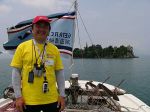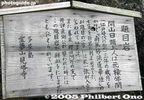 Image search results - "takeshima" Image search results - "takeshima" |

Takeshima island is connected by a bridge. The island is uninhabited, but has a Yaotomi Jinja Shinto shrine (八百富神社) dedicated to goddess Takeshima Benten. Designated as a Natural Monument for its flora which greatly differs from that on shore.
|
|

400-meter long bridge to Takeshima island near JR Gamagori Station. The island is made of granite. Circumference is 680 meters. There's a walking path around the island.
|
|

Torii on Takeshima island
|
|

Heading for Takeshima, a small island about 6.5 km off Hikone.
|
|

Masaki "Follow Me" Unose on the lead boat going to Takeshima island.
|
|

Takeshima is a small island with only Nichiren Buddhist temple and the priest's family living on the island. Accessible by boat from Hikone, Shiga Prefecture.
|
|

The island is noted for its giant stone monument inscribed with the prayer words "Namu Myo-horenge-kyo" from the Lotus Sutra.
|
|

Takeshima means "Island of Many Views" because it looks dramatically different from different angles.
|
|
|
|

Approaching Satsuma Beach, the final stop for the day.
|
|

Approaching Satsuma Beach.
|
|

Satsuma Beach in Hikone.
|
|

Hot rowers in a cool Lake Biwa.
|
|

Shabu-shabu lunch in Hikone with Omi beef. People had questions about how to eat the food. Cook the meat, vegetables, and udon noodles in the little shabu-shabu pot of boiling water, then dip into the sauce. One sauce for the meat, another for the udon.
|
|

After lunch, the group visited Hikone Castle and Genkyuen Garden. Hikone Castle is famous for cherry blossoms and Hiko-nyan (see next photo).
|
|

Watching Hiko-nyan, Hikone Castle's official mascot which is wildly popular. He performs daily inside Hikone Castle Museum. He is a white cat with a samurai helmet.
|
|

Steep stairs inside Hikone Castle tower.
|
|
|

Top floor of Hikone Castle tower. Hikone Castle's last lord was Ii Naosuke, the Chief Minister of the Tokugawa samurai government. He was the one who agreed to open Japan to the USA in 1858 after Commodore Perry visited.
|
|
|

My video of the the group rowing from Nagahama to Hikone (Satsuma) on June 9, 2011.
|
|

June 10, 2011 (Day 7): Satsuma Beach in Hikone. Someone camped here overnight to watch over the boats.
|
|

Preparing to leave Satsuma Beach.
|
|
|
|
|

Leaving Satsuma Beach.
|
|

Takeshima ("Island of Many Views") is a small island (600 m circumference) in Lake Biwa off Hikone, accessible by a short boat ride from Hikone Port.
|
|

Takeshima shows many different shapes depending on your viewpoint. A Nichiren temple and the priest's family are on the island. Boat for Takeshima at Hikone Port. The island is only 6.5 km from Hikone.
|
|

Hikone Port
|
|

Hikone Castle as seen from Lake Biwa.
|
|

Cormorants. There are to many of them and they deplete fisheries in the lake and cause forest damage.
|
|

Kawau cormorants. Shiga has over 40,000 of these birds, and 30,000 of them live on Chikubushima whose trees are being destroyed by the droppings and branches broken off to make bird nests.
|
|

To Takeshima
|
|

Almost no one in the boat
|
|

Takeshima in Hikone, Shiga. Map
|
|

Nichiren Monument on Takeshima. This giant stone monument is inscribed with the prayer words "Namu Myo-horenge-kyo" from the Lotus Sutra. 南無妙法蓮華経
|
|
|
|
|

Enter Takeshima
|
|

Nichiren temple
|
|
|
|
|
|
|
|
|
|

Lotus Sutra monument. In the early 17th century when the temple was built here, it took 3 years to carve out these characters on this stone slab. According to legend, this monument oozed blood when Ii Naosuke, Lord of Hikone, was assassinated in Tokyo.
|
|

Nichiren statue. Nichiren was the founder of the Nichiren Sect of Japanese Buddhism.
|
|

Nichiren statue is next to the giant stone monument.
|
|
|

It says that the stone monument oozed blood when Ii Naosuke, Lord of Hikone, was assassinated in Tokyo by samurai radicals from Mito, Ibaraki Prefecture.
|
|
|
|
|
|
|

View of Takeshima. Before the boat left, it circled around the island to show how different it looked from different angles.
|
|

View of Takeshima
|
|

View of Takeshima
|
|

View of Takeshima
|
|

View of Takeshima, an island with many shapes.
|
|

Another view of Takeshima
|
|
|
|
|
|
|